#restricted use pesticide
Photo

91 notes
·
View notes
Text
Un-Actions, or Restriction of Activities
This is my first post in a series I’ll be making on how to increase biodiversity on a budget! I’m not an expert--just an enthusiast--but I hope something you find here helps!
There’s a good handful of ways you can help increase biodiversity in your yard that don’t require buying things--in fact, these may actually help you save money in the long run! They may seem small and simple, but every bit counts! Whether you can do these in totality, or just limit how often you do these actions, it’ll make a difference.
Not Mowing, or Mowing Less Often

Turf grass lawns are considered a monoculture, meaning they don’t provide much opportunity for insects to find habitat--so few other creatures find them enjoyable either. An expanse of turf grass is, in many ways, a barren wasteland in the eyes of wildlife--too exposed to cross, with few to no opportunities for food or shelter, leaving them exposed to blazing hot sun, freezing cold, or any predators that may be lurking nearby. A place to be avoided. The simple act of letting your grass grow unbothered gives a chance for wildflowers to grow, and for your grass to grow taller--providing more habitat for insects, which then provides more habitat to birds and other creatures that feed on said insects. Wildlife want nothing more than to skirt by unnoticed, so even leaving the grass tall along the edges of a fence or yard can help a little. Even restricting mowing to every other week, or at a higher blade setting, can be a huge help. If HOAs or city ordinances are fussy about lawn length in the front yard, you can likely still keep grass higher in the backyard. Or, you can create a ‘feature’ where grass is allowed to grow long in a specific area. If it looks purposeful, people are more likely to accept it. Not mowing under trees or close to shrubs not only leaves space for wildflowers to grow, but also means you don’t have to deal with mowing over bumpy roots and other difficulties. Cutting different areas at different times can be an option for letting grass grow long in some areas while still having available places for play and entertainment. I’ve seen some people plant flower bulbs when pulling up weeds, so in the future they'll bloom in early spring before mowing is usually necessary. This could be another fun way of adding biodiversity to a lawn without--or before you--begin mowing in spring.
Not worrying about mowing, or doing it less often, saves you in time, money, and energy. You won’t have to buy as much gasoline for your mower, and Saturday afternoons can be free to be enjoyed in other ways aside from being sticky and sweaty and covered in grass stains. In addition, you’ll likely be lowering your own carbon emissions!
If you do have to mow your lawn, I’ve got ways you can use your grass clippings to boost biodiversity later in the post series!
Not using pesticides, herbicides, fungicides, etc.
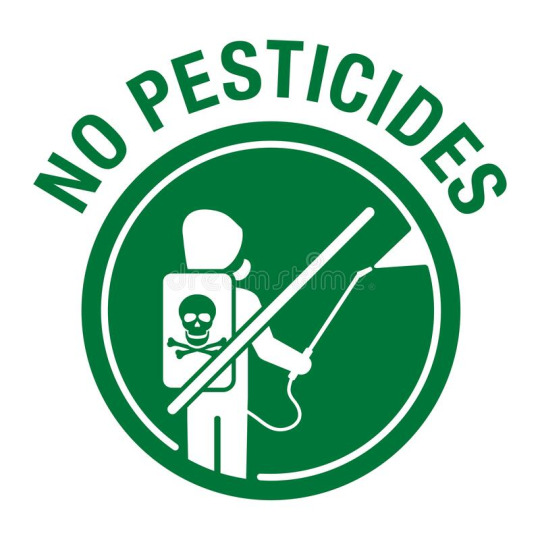
One of the next-biggest non-actions you can do asides from not mowing is using fewer fewer to no herbicides, fungicides, and pesticides in your yard. This’ll easily allow for more biodiversity. Allowing more insects and a wide array of plants to thrive will feed back into the entire food chain in your area. In addition, these types of chemicals have been tied to algae blooms, death of beneficial insects, harm to birds, fish, and even humans. Soil is supposed to be full of fungi, especially fungal mycelium that essentially acts as a network for plants to communicate, share nutrients, and support each other--fungicide kills that, and typically makes all other lawn problems even worse in a negative feedback loop. It may take awhile to see the benefits of avoiding these chemicals, but once you see it, it really is astounding.
However! I can’t lie and say that there haven’t been points where I needed to use pesticides at some points in my gardening journey. In these cases, try to use products that are organic--like diatomaceous earth, neem oil, etc--and use them accurately, correctly, and sparingly. Follow instructions on how to apply them safely and responsibly--for example, on non-windy days and during times when bees and other pollinators aren’t likely to be out and about. With some pests (read: oleander aphids, in my experience), a simple jetstream of water is enough to force them off the plant where they’ll be too weak to get back. Eventually, you should have a balanced enough ecosystem that no one insect pest causes a major issue with the work you’re doing to boost biodiversity.
If you can bear to, try handling pests manually. Squishing pest bugs in your hand is a pretty foolproof way to get rid of some problems, or spraying them with a mix of soap and water can do the trick on some insects. Alternatively, picking them off your plants and into a bucket of soapy water is also a valid option. You’ve heard of baptism by fire, now get ready for… baptism by soap?
But also! Try reconsidering what you consider a pest! Tomato hornworms are hated by gardeners, for devouring the foliage of beloved tomato, pepper, and potato plants. But killing the tomato and tobacco hornworm means getting rid of sphinx moths, also known as hummingbird or hawk moths! Hawk moths are vital to the survival of many native plants, and are sometimes even the only species that pollinates them. If you can bear to, consider sacrificing a few tomato plants, or growing a few extras, so we can continue having these beautiful moths for years to come. After all, they may not even do significant damage to the plants!

With that in mind, be friendly to your natural pest managers! Lacewings, ladybugs, praying mantises, wasps, birds, bats, and more will help manage pest populations in your environment! Encourage them by planting things they like, providing habitat, and leaving them be to do their work! Avoiding pesticides helps make your garden a livable environment for them, too!
Letting Weeds Grow
Many of the plants we know as 'weeds' are actually secondary succession species and native wildflowers. Milkweed was regarded as a noxious, annoying weed for a long time, and now people are actively trying to plant them after learning about the important role they play in our environments! Weeds are adapted to take over areas that have been cleared out of other plants after a disaster, so they're doing much of the initial work in making a habitat for other creatures. In fact, many of them will simply die back as the environment repairs itself.
An important thing to note is to please make sure that your ‘weeds’ are not invasive species. Work on learning how to identify native and invasive species in your area, and pull out what’s harmful to leave room for what’s good!
Don’t Rake (Or At Least Don’t Bag Your Leaves)

Many insects overwinter in piles of leaves that we often rake away and bag up in the fall and winter. By doing this, we are actively throwing away the biodiversity of our neighborhoods! If you can, leave the leaves where they fall!
If you do need to rake, put the leaves in places wildlife can still access it instead of bagging it up. Move your leaves into garden beds to serve as mulch, or along the edge of fences to rest while keeping egg cases and hiding bugs intact and free to release come spring.
Leave Snags Where They Are
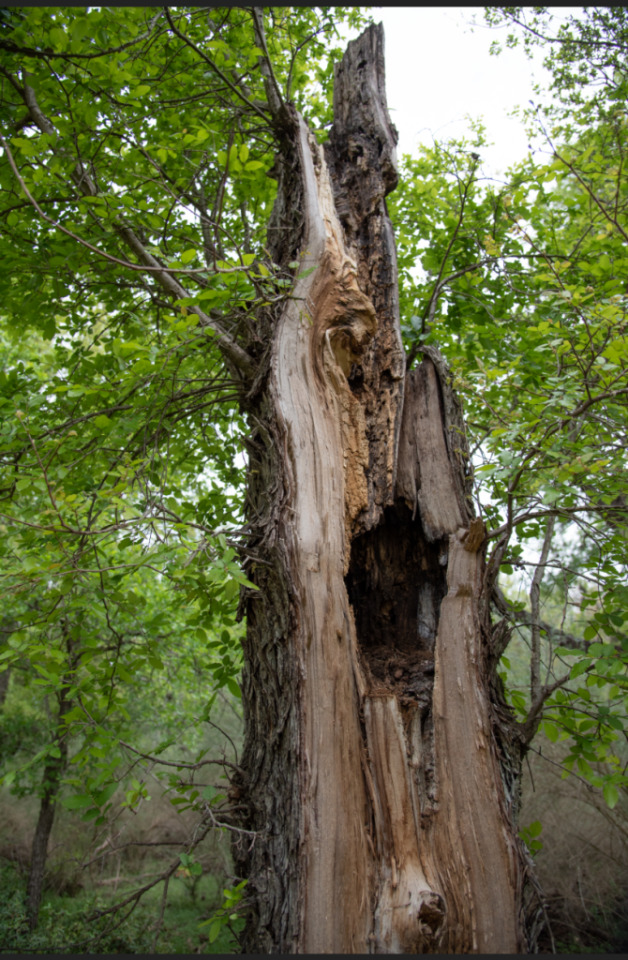
Snags are dead trees/dead branches on living trees. They provide an important wildlife habitat--many birds nest in them, or use them to seek cover from rain, and many insects will also live in snags (making them an additional food source for birds and other creatures). Tree cavities are used as nests by hundreds of bird species in the US, and many mammals use them as well, such as bats, squirrels, raccoons, and sometimes even bears. Some trees form cavities while they’re still alive, but in conifers they’re more likely to form after death. Crevices between the trunk of a dead tree and its peeling bark provide sun protection for bats and amphibians, and leafless branches make great perching areas for birds of prey to hunt from above. The decaying wood is home to insects and fungi, who then feed birds, mammals, amphibians, and reptiles. Do check on the snags regularly to ensure they don’t serve a threat to any nearby structures, but whenever possible, leave them be!
Keep Your Cat Inside
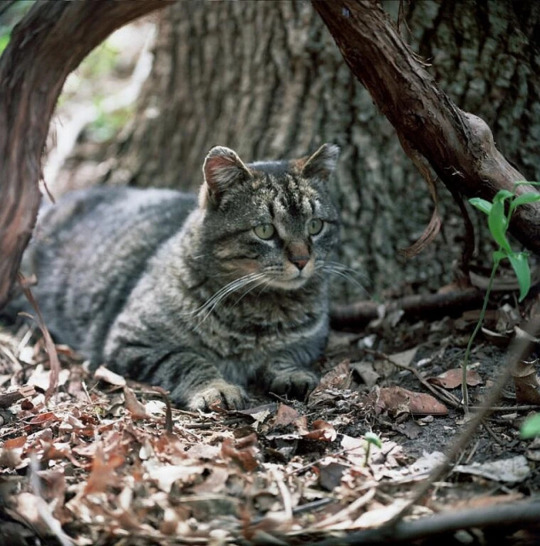
If you have an outdoor cat, consider making the adjustments to have it be an indoor cat. If you have an indoor cat, keep it as an indoor cat. Free ranging cats impact biodiversity through predation, fear effects, competition for resources, disease, and more. Keeping little Mittens inside does a lot more to help than it may seem from the outside.
That’s the end of this post! My next one’s gonna be on things you can add to your space that aren’t directly related to growing plants. For now, I hope this advice helps! Feel free to reply with any questions, success stories, or anything you think I may have forgotten to add in!
#biodiversity#solarpunk#gardening#outdoor gardening#lawn culture#anti lawn culture#environmental stewardship#(i think that counts)#ani rambles#out of queue#the biodiversity saga#I know I said this in the masterpost already but another reminder some people aren't in a position to do all or some or even any of this#i have so far been unsuccessful in convincing my parents to not mow or rake because we live in an HOA neighborhood#but do what you can/are able to! it'll help!
1K notes
·
View notes
Text
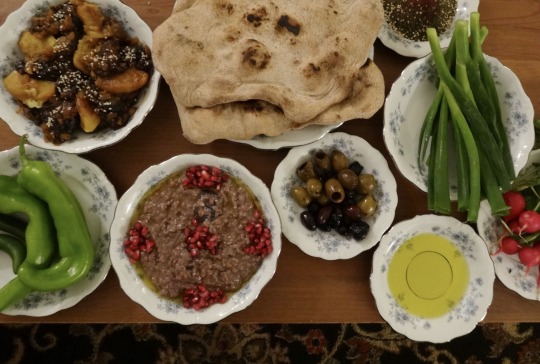

[ID: A purplish-grey stew topped with olive oil and garnished with piles of pomegranate seeds. Plates of green peppers, bitter olives, olive oil, taboon bread, green onions, radishes, and za'tar surround the dish. The second image is a close-up of the same stew. End ID]
رمانية / Rummāniyya (Palestinian pomegranate stew)
Rummaniyya (رُمَّانِيَّة; also transliterated "rumaniyya," "rummaniya," and "rummaniyeh") is a Palestinian stew or dip made from lentils, eggplant, and pomegranate seeds, flavored with nutty red tahina and a zesty, spicy دُقَّة (dugga) of dill seeds, garlic, and peppers. A طشة (ṭsha), or tempering, of olive oil and onion or garlic is sometimes added.
"Rummaniyya," roughly "pomegranate-y," comes from رُمَّان ("rummān") "pomegranate," plus the abstract noun suffix ـِيَّة ("iyya"); the dish is also known as حبّة رُمَّانَة ("ḥabbat rommāna"), or "pomegranate seeds." It is a seasonal dish that is made at the end of summer and the beginning of fall, when pomegranates are still green, unripe, and sour.
This stew is considered to be one of the most iconic, historic, and beloved of Palestinian dishes by people from Gaza, Yaffa, and Al-Ludd. Pomegranates—their seeds, their juice, and a thick syrup made from reducing the juice down—are integral to Palestinian cuisine and heritage, and images of them abound on ceramics and textiles. Pomegranates and their juice are sold from street carts and cafes in the West Bank and Gaza.
Today, tens of thousands of tons of pomegranates are grown and harvested by Israeli farmers on stolen Palestinian farmland; about half of the crop is exported, mainly to Europe. Meanwhile, Palestinians have a far easier time gaining permits to work on Israeli-owned farms than getting permission from the military to work land that is ostensibly theirs. These restrictions apply within several kilometers of Israel's claimed borders with Gaza and the West Bank, some of the most fertile land in the area; Palestinian farmers working in this zone risk being injured or killed by military fire.
Israel further restricts Palestinians' ability to work their farms and export crops by imposing tariffs, unexpectedly closing borders, shutting down and contaminating water supplies, spraying Palestinian crops with pesticides, bulldozing crops (including eggplant) when they are ready to be harvested, and bombing Palestinian farmland and generators. Though Palestinian goods have local markets, the sale of Palestinian crops to Israel was forbidden from 2007 to 2014 (when Israel accepted shipments of goods including tomato and eggplant).
Gazans have resisted these methods by disregarding orders to avoid the arable land near Israel's claimed borders, continuing to forage native plants, growing new spices and herbs for export, planting hydroponic rooftop gardens, crushing chalk and dried eggplants to produce calcium for plants, using fish excrement as fertilizer, creating water purification systems, and growing plants in saltwater. Resisting Israeli targeting of Palestinian food self-sufficiency has been necessary for practical and economic reasons, but also symbolizes the endurance of Palestinian culture, history, and identity.
Support Palestinian resistance by calling Elbit System's (Israel's primary weapons manufacturer) landlord; donating to Palestine Action's bail fund; and buying an e-Sim for distribution in Gaza.
Serves 6-8.
Ingredients:
For the stew:
1 medium eggplant (370g)
1 cup brown lentils (عدس اسود)
600g pomegranate seeds (to make 3 cups juice)
3 Tbsp all-purpose flour
1/4 cup red tahina
1/2 cup olive oil
Salt, to taste
Citric acid (ملح الليمون / حامِض ليمون) (optional)
Red tahina may be approximated with home cooking tools with the above-linked recipe; you may also toast white tahina in a skillet with a little olive oil, stirring often, until it becomes deeply golden brown.
For the دُقَّة (dugga / crushed condiment):
2 tsp cumin seeds, or ground cumin
1 1/2 Tbsp dill seeds ("locust eye" بذور الشبت / عين جرادة)
5 cloves garlic
1 green sweet pepper (فلفل بارد اخضر)
2 dried red chilis (فلفل شطة احمر)
People use red and green sweet and chili peppers in whatever combination they have on hand for this recipe; e.g. red and green chilis, just green chilis, just red chilis, or just green sweet peppers. Green sweet peppers and red chilis are the most common combination.
For the طشة (Tsha / tempering) (optional):
Olive oil
1 Tbsp minced garlic
Instructions:
1. Rinse and pick over lentils. In a large pot, simmer lentils, covered, in enough water to cover for about 8 minutes, or until half-tender.
2. Meanwhile, make the dugga by combining all ingredients in a mortar and pestle or food processor, and grinding until a coarse mixture forms.

Dugga and components.
3. Cube eggplant. A medium-sized eggplant may be cut in half lengthwise (through the root), each half cut into thirds lengthwise, then cubed widthwise.


Cubed eggplant, red tahina, and pomegranate seeds.
4. Add eggplant to simmering water (there is no need to stir).
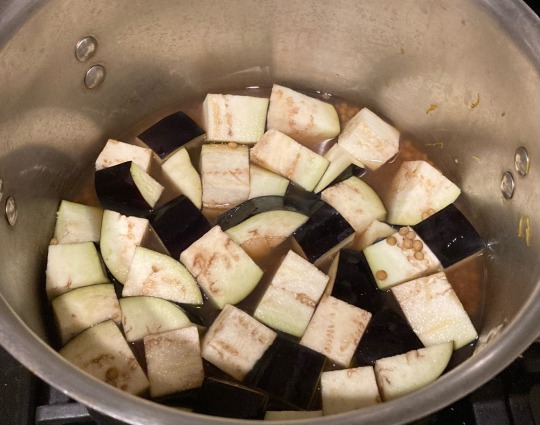
5. While the eggplant cooks, blend pomegranate seeds in a blender very thoroughly. Strain to remove any gritty residue. Whisk flour into pomegranate juice.

Pomegranate juice being strained.
6. Taste your pomegranate juice. If it is not sour, add a pinch of citric acid or a splash of lemon juice and stir.
7. Add dagga to the pot with the lentils and eggplant and stir. Continue to simmer until the eggplant is very tender and falling apart.
8. Add pomegranate juice, tahina, and olive oil to the pot, and simmer for another 5 minutes, or until stew is very thick and homogenous.

Bright pink pomegranate juice in stockpot.
9. (Optional) In a small skillet, heat a little olive oil on medium. Fry minced garlic, stirring constantly, until golden brown. Add into the pot and stir.
10. (Optional) Mash the stew with the bowl of a ladle or a bean masher to produce a more homogenous texture.
Serve rummaniyya hot or cold in individual serving bowls. It may be served as an appetizer, or as a main dish alongside flatbread, olives, and fresh vegetables such as radishes, green peppers, green onions, carrots, and romaine lettuce. It may be eaten with a spoon, or by using كماج (kmāj), a flatbread with an internal pocket, to scoop up each bite.
559 notes
·
View notes
Note
I think a critical flaw in the vegan’s user’s argument was that they clearly buckled down on how capitalist exploitation and overproduction factors into milk and meat markets… and then seemed to assume that vegan diets avoid capitalist pitfalls completely.
But you’ve already posted on your blog before about how crop production under capitalism has created huge environmental issues in terms of biodiversity, depletion of topsoil, and sustainability. Meaning even a non-animal diet can (especially on the scale necessary for every human being currently in existence) still create large-scale issues if that diet demands having specific foods in abundance to avoid eating meat.
Like, I’m sympathetic to what vegans want to do, it just feels like they’re ignoring a MASSIVE number of pressing logistical and environmental issues to push that agenda. There’s several intersecting problems here, and claiming humanity as a whole is poised to chuck eating animals completely seems to be jumping the gun.
This is basically exactly what I hope to convey to people. I feel like extremely pressing issues such as topsoil loss, pesticide and herbicide use, and pollution caused by nitrogen fertilizers, not to mention the severe biodiversity impacts of monoculture, are being disregarded in favor of a very simplistic "Meat is killing the Earth" argument.
And I think the "veganism to save the earth" idea is just...distracting, as a movement. I'm glad people are motivated to do it. I don't think it's bad. But we need people to take action beyond just Buy Product. Anyone telling you that the most important action you can take is Buy Different Product does not have your best interest, or the planet's best interest, in mind.
If you're eating a plant based diet, but your only relationship with your food is Buy Product, you are still alienated from the source of your food. You still don't know, and can't respect or care for, the ecosystem or the labor that gives it to you.
My agenda is far more along the lines of "society needs to be organized so more people are directly involved in growing food that feeds their community" than anything to do with animals, but it's clear to everyone who has studied it for 2 seconds that farming needs to change hugely and it's so, so much more complicated than "farming animals is bad, farming plants is good."
Also the fact is that veganism cuts you off from sources of nutrients that have been part of virtually every human society ever, a LOT of people have disabilities, allergies or nutrient absorption issues that mean going vegan isn't possible for them, and people who try to argue with me about this simply Stop knowing how to read when this is brought up. "Some people need animal protein to live" is a reality of the world but people who don't like this straight up refuse to consider it.
I have no food allergies or sensitivities, and I still struggle to eat enough food to live. I lost thirty fucking pounds in college because of stress, the dining hall being shit, and my roommate trying to control my eating habits (long story). Thats like...well over 1/5 of my body weight. Sometimes people Cannot restrict their diet safely.
Like, sure, I 85% agree with the vegans who like to comment on my posts, but the remaining 15% of things they say is completely insane.
And some of them are so out of touch with reality that they will swear up and down that it's impossible for humans to drink milk without someone having to murder a baby animal. They seem to think farming is exclusively some kind of horror show that happens in a warehouse somewhere, and don't understand the concept that "some people live in rural areas" or "it's not uncommon in some places to just keep a few dairy goats that provide milk for your family."
And if they admit this exists, it's like "well, that's not where your dairy comes from, because the INDUSTRY—" thats. that's my point, you can get milk from a farmer who keeps a small herd that is well treated, we should start doing this actually, you can even keep your OWN goat
my ideal world involves "backyard chickens and goats are legal in suburban areas where there's space" because there's literally nothing innately unethical about keeping a couple dairy goats or healthy heritage breed chickens and you can quote me on that and you can even fight me.
That one person (the one who kept bringing up eating poop) (Lord what a sentence to have to write) eventually turned to "Well those sources are wrong because governmental organizations want you to keep eating animal products" which is already well into "conspiracy theory" territory. No thanks.
707 notes
·
View notes
Text
figured i would do a quick write-up about JADAM farming techniques since there's only one post about it that I could find on tumblr and you're not likely to find a more niche subset of organic farming-
TL;DR:
JADAM is a korean grassroots organic farming method that uses 3 recipes (a soil microbiome solution, a pest/disease control solution, and a surfactant) to increase yields cheaply and organically, scalable to both small-scale gardens as well as industrial agriculture.
youtube
Above is the inventor's youtube channel, and although most content is in Korean, it has enough English-language instructional content to get the basic idea across.
The most interesting aspect to me is the JMS (JADAM Microorganism Solution) that improves the soil microbiome and and nutritional diversity. By blending and steeping leaf mold, salt, and boiled mashed potatoes, you can make an entire drum of intense living fertilizer in a few days.
The JADAM sulfur solution that is used as pesticide is less convenient for a small home gardener due to the inherent risk of inexperienced gardeners creating chemical reactions with sulfur and caustic soda, but if utilized on an industrial scale could cut back pesticide usage so significantly.
I believe that large scale organic farming is too focused on hydroponic growing due to FDA/USDA organic restrictions being so inflexible, and that a revolution in the organic scene is necessary to allow for "true" (non-hydroponic) organic growers to continue existing, and the JADAM system offers a cheap and effective way of farming organically.
The JADAM "Ultra-Low-Cost Agriculture" philosophy is an ideal organic agricultural system, and I really hope it starts to get more attention outside of Korea so that we can more closely examine its feasibility.
#JADAM#organic gardening#organic fertilizer#gardening#gardenblr#plantblr#farming#vegetables#solarpunk#Youtube#Korea#Agriculture
13 notes
·
View notes
Note
I'm missing something here. Why is the golf course thing so awesome? What water ban exemption???
Golf courses are ecological catastrophes that only benefit the rich and I hate them. The use of water alone is atrocious, never mind the blow to local pollinators from the monoculture non-native grass snd use of pesticides.
They also tend to be able to suck up as much water as they want, even when the rest of a community is asked/told to restrict watering their lawns/gardens/parks during drought conditions. Golf courses will petition to get an exemption to water restrictions to keep dumping water on their shitty non-native turf grass, and often get permission to do so.
On a social level, lots of golf courses are municipal/public maintained, but have costly fees to use (the ones in Austin run around $30 per person, plus you have to own your own gear) - meaning that these environmental tragedies are also paid for with your tax money but can only really be used by the reasonably wealthy. (Instead of a public park or library or space that is accessible to low income folks.)
201 notes
·
View notes
Text
“A nation that destroys its soils destroys itself.” — Franklin D. Roosevelt
Therese Coffey, the woman who brought 2.4million hours of undiluted raw sewage discharge into our waterways, now brings us 36 toxic chemicals used in farming.
One of the great advantages of having cast of the restrictive shackles of the European Union, is that the Tory Party is now free to poison us in the pursuit of profit.
The privately owned water companies have polluted our waterways and beaches and now landowners are being allowed to contaminate the countryside with dangerous chemicals.
“UK fails to ban 36 harmful pesticides outlawed for use in the EU.” (Guardian: 13/09/23)
Do not be mistaken in thinking that the farming industry is a collection of small family businesses. They do exist, but the aristocracy and big agribusiness are the biggest owners of farmland.
The Farmers Weekly recently described Britain’s agricultural resources thus:
“Land is a finite resource, offering relatively stable, long-term growth, hedging (limiting financial risk) and wealth preservation opportunities…Greater profitability and stability attracted investors, both domestic and foreign, to UK land, replacing some of the more traditional landlords such as royalty and the church.” (Who Owns Britain's Farmland: 17/01/23)
It is interesting to note that food production in not mentioned once in connection with farmland. It is all about long-term investment and profitability. According to Farming Forum, the aristocracy owns 30% of UK farming land, big corporations own 18%, tycoons own 17% and 17.5% of farmland ownership is “unknown”. “Individual homeowners” own only 5% of farmland.
Could it be that once farmland is seen as an investment opportunity rather than a means to produce and secure the nations food supply in an environmentally sustainable way, that the safe and long-term stewardship of the land becomes subservient to maximising profits at any cost?
Whatever the answer to that question is, Britain is now being described as “the toxic poster child of Europe” because of our controversial pesticide policies.
The first job of any government is to protect its citizens, yet Therese Coffey is allowing the use of chemicals that are directly harmful to human health. 12 of the chemicals being allowed are classified as carciogens and cause cancer. 9 of the chemical can cause human birth defects, developmental disorders and infertility. 8 of the chemicals can adversely affect reproductive function and development in both adults and children, and one of the chemicals being authorised by Coffey is classified as “acutely toxic”, meaning a single exposure can have detrimental health effects, usually within 24 hours of exposure. (See Pesticide Action Network UK: UK Falling behind EU pesticide standards; 13/09/23)
14 notes
·
View notes
Text
Cancer patients are celebrating a string of courtroom victories after juries in three US states recently ordered Germany’s Bayer to pay more than $500 million in damages for failing to warn about the health risks of its Roundup herbicides. But the consumer wins come as proposed federal legislation backed by Bayer and the powerful agricultural industry could limit similar cases from ever going to trial in the future.
Dubbed the Agricultural Labeling Uniformity Act, the proposed measure would provide sweeping protections for pesticide companies and their products, preempting local governments from implementing restrictions on pesticide use and blocking many of the legal claims that have been plaguing Bayer, according to the American Association for Justice (AAJ) and other critics
Everyone is bought off.
8 notes
·
View notes
Text
"Thanks to the persistence of state legislators, and a change of heart from Governor Gavin Newsom, California has passed a new law that will ban over-the-counter sales of lawn and garden neonicotinoid pesticides by 2025, limiting their use to trained professionals in the heavily agricultural state.
AB 363 restricts the sale of the pesticide class, also known as neonics, and directs the Department of Pesticide Regulation to conduct an analysis of the worst uses of neonics and take necessary steps to prevent environmental damage."
9 notes
·
View notes
Text
i still think the hate against golf is just performative culture wars bs. while there are certainly many real problems with it, none of them are really inherit such that it necessitates it being abolished 'after the rev'.
'b-b-but it's a sport for the rich!' ok, so equalize it. make it available to everyone. each course could have its own equipment library. build apartments in the surrounding area with some well connected public transit. make it cheap and eliminate restrictions on who can join in on the fun.
'b-b-but the pesticides! the ecological damage!' there are already organic courses. additionally, early courses were built along sandy dunes or w/e with native grasses and 'mown' with sheep. they were minimally landscaped. i also doubt even half of the people who'd complain about the use of pesticides eat an exclusively organic diet.
'b-b-but it uses so much land! it should be a public sex forest garden!' i think this is a non-issue honestly. it's really such an incredibly small fraction of a fraction of land use. urban land use in general just pales in comparison to agriculture land use. and as state before, golf courses could be built on otherwise 'unhabitable' land such as dunes. meanwhile, agricultural use accounts for nearly half of all habitable land, around 80% of which goes to animal agriculture, despite farmed animals only accounting for about 17% of the world calories and 38% of its protein. also, no one ever seems to want apply the same critique of 'unproductive' land use to parks. because generally people recognize that parks are a social good.

it really, as far as im concerned, all just boils down to 'golf' being a fixed image of some 'snooty rich people' sport, a neat little prepackaged way to virtue signal in a way that, if it were to be abolished, wouldn't actually necessitate any change in lifestyle of those who advocate against it. curious.
#golf#abolish golf#aside from ruining my apartments grass as a kid with some dumpsterdived clubs#and disc golf#ive never even played golf#i just think people are so fucking stupid about this
6 notes
·
View notes
Photo
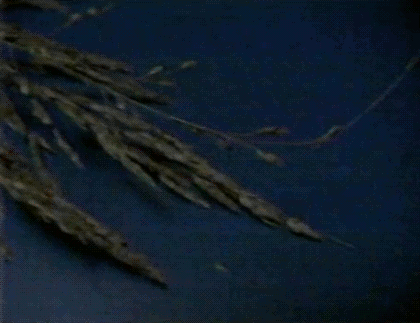
#disturbing herbicide commercial#treflan#johnsongrass#herbicide#vhs#gif#1985#restricted use pesticide#mousetrap#agriculture
38 notes
·
View notes
Note
when you say most people are able to live without eating meat/animal products, who isn’t included in that
It’s hard to give any sort of exhaustive list, but there are some very real barriers for some people. If you live in a food desert eating plant-based can be inaccessible for example, there are people with some extreme food sensitive issues that make it very difficult as well. Similarly, while some people with eating disorders find veganism very helpful in reframing food as a positive choice, for some the mere act of restricting anything food type and ingredient checking can be triggering.
The thing to recognise is that the ideal of veganism, a lifestyle involving zero animal exploitation, is not attainable for most people, not just a select few. Medications aren’t usually vegan, furniture, cars, even our crops can harm animals through chemicals, pesticide use and clear cutting. That’s why veganism should be seen as something we are constantly striving for rather than something we can attain.
130 notes
·
View notes
Photo
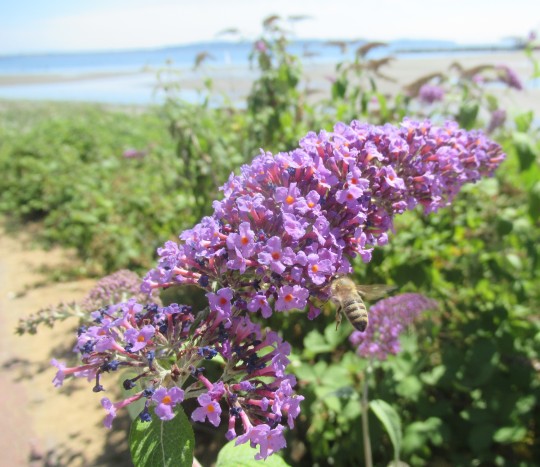


Buddleja davidii (Butterfly bush) and Apis mellifera (Western honey bee)
Globalisation
Whenever I’m visited by out-of-town friends in the summer, I usually take them down to the beach to get a bit of that West Coast vibe. The plant community is the very picture of globalisation because the only native plant that I see in abundance is the common horsetail (Equisetum), and that doesn’t count because horsetails are found everywhere except Antarctica.
This species of Butterfly bush (Buddleja davidii) is originally from central China and parts of Japan. It arrived in European gardens in the 1890′s and was already being declared an ‘invasive weed’ in Britain in 1922. Here it prospers on the other side of the Pacific Ocean, “duking it out” with a host of other introduced plant species.
Butterfly bush is often grown as a garden ornamental because it is attractive to butterflies. However, this particular ‘garden escapee’ is being pollinated by a honey bee. Butterflies are sensitive to habitat destruction, pesticide use and, increasingly, climate change. As local gardeners, we don’t see that many butterflies around these days but these honey bees are part of the problem too.
In 2021 the global honey market was worth 8 billion dollars with over 94 million registered bee hives world-wide. The number of hives is expected to grow another 8% in the next five years. Each bee hive can consume 250 kilos of nectar and 50 kilos of pollen a year, and this represents enormous competition to native pollinators of all kinds, especially bumblebees and butterflies. Some jurisdictions are now considering restricting the number of honey bee hives to assist conservation efforts and increase biodiversity.
#flowers#photographers on tumblr#butterfly bush#honey bee#globalisation#fleurs#flores#fiori#blumen#bloemen#white rock beach#vancouver
111 notes
·
View notes
Video
youtube
Be Healthy With Organic Flower Delivery
Obviously everyone loves flowers! At the point when individuals are miserable, it satisfies them. At the point when individuals are infatuated, it makes their reality more vivid. At the point when individuals are wiped out, their loved ones give them find out more here flowers to cheer them up. At the point when they are discouraged, it ease up their temperament etc. These are just the exceptionally simple signs of what I'm talking about. Flowers are simply overwhelming.
This makes sense of why the interest for flowers is just simply growing. A few shops are growing like mushrooms may it be in the city, inside the shopping centers and the most recent is on the web. Notwithstanding, it is observable that most flowers on the racks of these shops are imported which usually come from Different Nations. These turn out in the rundown when the issue of business flowers available is raised. To have the option to keep up with the newness of the flowers, a few synthetics are used in these nations. In any case, it isn't just modest quantity of pesticides however it has been found out that exceptionally harmful pesticide and insect sprays are showered on these flowers. We could ponder the impacts of this in our bodies. Indeed, the word poisonous pesticides illuminate cardiovascular-related infections, neurological sicknesses and, surprisingly, conceptive issues. Beside that, there are other future secondary effects that our bodies could get when we keep using business flowers.
Presently, using sans pesticide flowers comes out when individuals began to feel that perils of business plants. These are even restricted from entering a few nations these days and many shops are offering organic flower delivery around the country. By organic way, we mean the flowers that are grown by organic homesteads. These homesteads attempt to allow the blossoms to grow at their own speed without the mediation of pesticides or growers. As opposed to the business flowers, these businessmen attempt to speed things up for the business and that incorporates the growth of the flowers. Shops that offer organic flower delivery use confirmed organic flowers and it is just one of the most secure ways of safeguarding your health and your family's health.
Beside the health benefits we could get from organic flower delivery, there are likewise a few natural advantages that we get from organic flowers. The risks that business flowers present are just countless that organic flower delivery is the most ideal decision.
They may be lovely and are generally excellent decision for improvements however we need to wise while requesting them. Issues will emerge with business ones yet the health of the entire family is guaranteed. Be wise and pick organic flowers over lovely and faultless plants.
8 notes
·
View notes
Text
Despite calling the question ridiculous, Ernesto made a good point on ecto-friendly lawns.
Mayor Ernesto Montez's caustic response to an innocuous question from Amity News about lawn maintenance has prompted a deeper discussion about ecto-friendly lawns.

Amity News was approached earlier this summer by residents who live in the area of south of Park Road who were complaining about the state of the lawn at what they believed to be Montez residence. The grass there had not been cut once this year. It turns out Montez says he does not live there anymore- he used to, but she said it is the home of his ex-wife only. The Mayor responded to our questions by calling these former neighbours “pretentious and dimwitted”.
“Absolutely AMAZING that this is “newsworthy” in your opinion.
I do not live at that property, I haven’t for well over a year.
Your gossip is inaccurate and quite frankly, ridiculous.
There are several people in that neighbourhood who choose to leave their lawns, it is good for pollinators.
I cannot speak for my ex, though I would be interested to hear how her choice to leave her lawn is impacting the lives of these pretentious and dimwitted neighbours. What a beautiful life they must live if this is of such great concern to them,” the mayor wrote in an email to Amity News.
We stand by our questions of the mayor. Amity News was merely trying to determine if any of the city bylaws were being violated with the lawn not being maintained. It is addressed by this section of the home and property bylaw:
“The Property Maintenance By-law is primarily concerned with the general appearance of a property. Maintenance standards include restrictions on grass and weed height, and the storage of junk, garbage, inoperable machinery and vehicles. The timelines for compliance are much shorter than under the Property Standards By-law. This by-law tends to be applied when a particular property doesn’t have the same degree of maintenance as the others in a neighbourhood.”
The bylaw states growth in excess of 20 cm is not permitted as well as ecto-entity plants.
Those neighbours who complained to us about the state of the lawn have a recourse in the complaint section of the bylaw:
“Before filing a property standards complaint, please ensure that you have done all you can do to resolve the problem. This would include notifying the property owner or the landlord/property manager about the nature of the problem. You cannot expect someone to address an issue if they do not know about it,” it states.
It is unclear whether any neighbours have filed an official complaint, or if Therrien is still an owner of the property. Neighbours report seeing her vehicle in the driveway on a regular basis.
Amity News then reached out to the environmental organization Amity/Elmerton GreenLawns to talk about environmentally-friendly and Ecto-friendly lawns.
“A lawn is really an outdated symbol of status. It’s a colonial thing,” said GreenLawns director of programs Heather Tompkins. “We promote people moving away from having a lawn and moving towards having more tolerant native species that require less water input and no pesticides – lawns that provide actual ecological function. Ectoplants are also an option in Amity do to the high ectoplasm in the ecosystem but there isn't that much research on the plants.”
33 notes
·
View notes
Text
78 - pumpkin

The Pumpkin
So uhhh.... I thought that the pumpkin was starting to yellow, so I picked it. I think it was a great idea too since there was a caterpillar, who I trusted with my heart because many butterflies have been suffering in my vicinity, consuming the innards of my pumpkins. Honestly, I think it was ready for a while since its size had not changed. For the other future pumpkins, I did what had to be done and sprinkled pesticide on the plant.
Stream
Today was an amazing Pooepw double feature. I played the game Odd Realm, then I started actually playing the game Diablo IV. In Odd Realm, I did make an error in playing as a race other than human. I did not really get to feature the game play that I wanted to; the ancient race played like an entirely different game to playing as humans. I will probably play the game again just using the save that I have already built up. As for the Diablo IV game play, I was going to choose a different class and start anew, but I decided that I wanted to keep doing Druid Gaming. I already had a Druid that I made to test that the actual game was working and not just menus. My impression of the game is that it is much more story based than Diablo I and II. Diablo III tried to have more story, but it did it in the bad way where there were just audio files telling the player about the lore. I also think that Diablo IV is a bit more restrictive than Diablo II in terms of character builds, but I still enjoy it. I will be playing it more for sure.
man that's a bunch of tags
|
|
V
#gaming#imgamer#small streamer#blog#diablo iv#diablo 4#diablo#pumpkin#growing plants#gardening#odd realm#indie gaming
4 notes
·
View notes